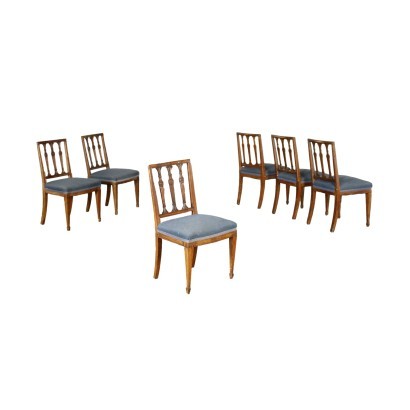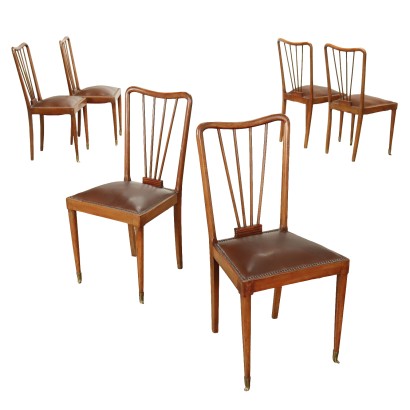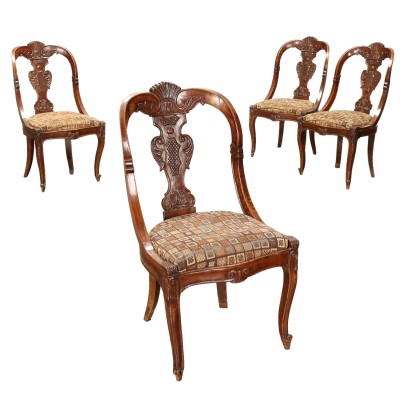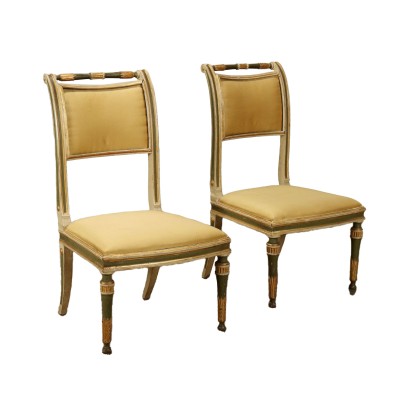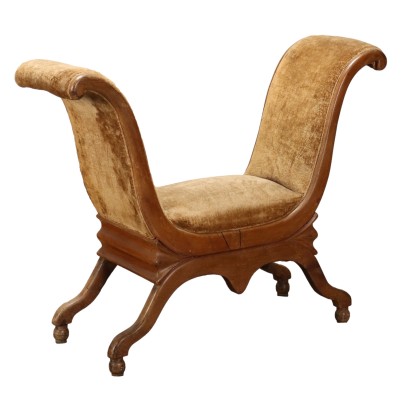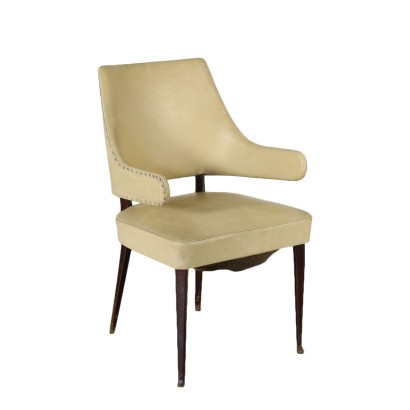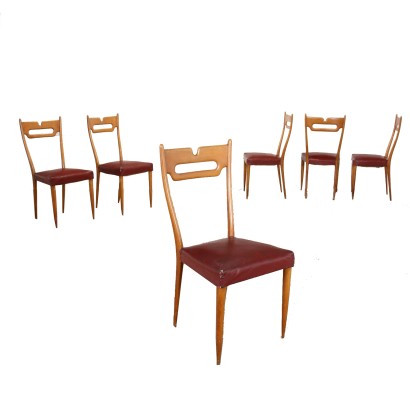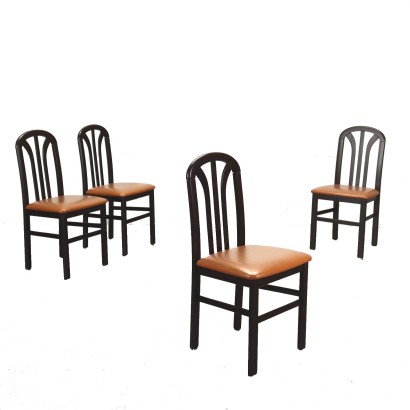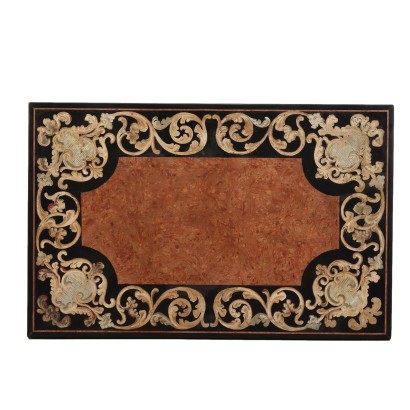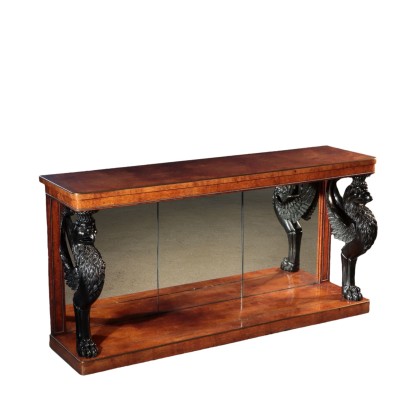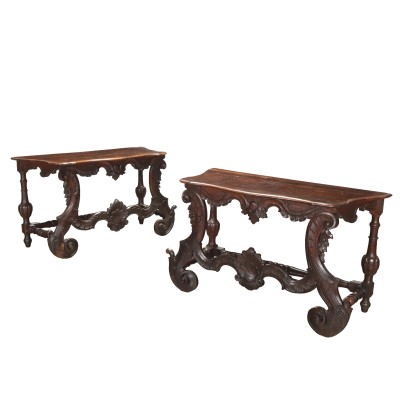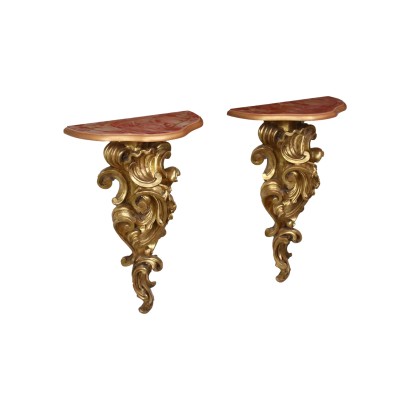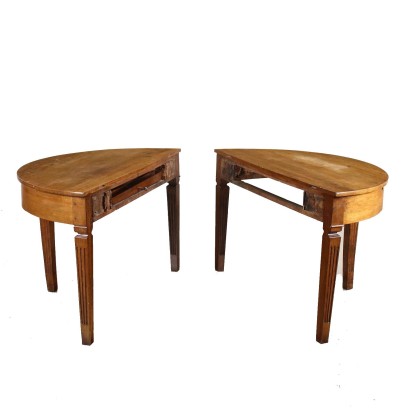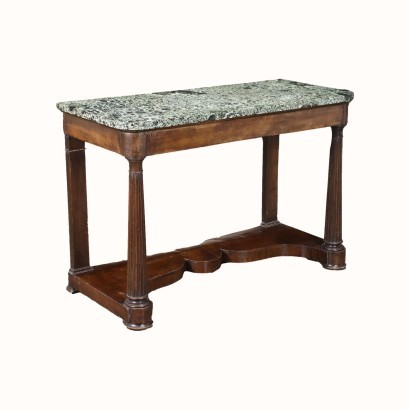Group of Sheraton Style Chairs Walnut Cherry Italy 18th-19th-20th Cent
Features
Style: Neo-Classical (1765-1790)
Age: 19th Century / 1801 - 1900 , 18th Century / 1701 - 1800 , 20th Century / 1901 - 2000
Origin: Livorno, Italy
Material: Padded
Description
Group of 6 walnut and cherry Sheraton style chairs; 3 of them are neoclassical, the thers have been made in 20th century. They have saber shaped rear legs and pyramidal truncated frontal ones with a leafy engraving; padded seat and backrest carved with a motif of columns surmounted by phitomorphic elements. In correspondence with the columns, on the upper part of the back, there are 3 carved floral elements. The three antique chairs can be dated to between the end of the eighteenth century and the beginning of the nineteenth century, made on the Sheraton model probably in Livorno, where the presence of a large English population greatly influenced the production of furniture.
Product Condition:
The item shows signs of wear due to age. Any damage or loss is displayed as completely as possible in the pictures. It may require restoration and recovery of french polish.
Dimensions (cm):
Height: 90,5
Width: 51
Depth: 54
Seat height: 47
Additional Information
Style: Neo-Classical (1765-1790)
This historical period includes a first phase that can be properly defined as the Louis XVI style.nOnly at a later time, with the maturation of archaeological fashions, was a new vision of furnishing civilization formulated and codified, now fully attributable to the Neoclassical Style.
In fact, both trends coexisted in unison until the last years of the eighteenth century.
nIn the field of cabinet making, the Directoire, Retour d'Egypte, Consular and Empire styles also fall within the neoclassical era.
nFind out more about Neoclassicism with the insights from our blog...
n
Age:
19th Century / 1801 - 1900
19th Century / 1801 - 190018th Century / 1701 - 1800
18th Century / 1701 - 180020th Century / 1901 - 2000
20th Century / 1901 - 2000Main essence:
Cherry
Obtained from prunus cerasus , a plant of oriental origin, it is a hard wood with a light and delicate color, with a reddish vein. Due to its diffusion and availability it was used in Europe in popular furniture. In cabinet making, in the seventeenth century, it was widely used in France and England for inlay work. In Italy it was very successful in Lucca. It was also very popular in the United States for the manufacture, from the late 1600s, of commonly used furniture.The dictionary of antiques: Eclecticism
Classic Monday: a sofa from the 1800s example of eclecticism
Walnut
Walnut wood comes from the plant whose botanical name is juglans regia , probably originally from the East but very common in Europe. Light or dark brown in color, it is a hard wood with a beautiful grain, widely used in antique furniture. It was the main essence in Italy throughout the Renaissance and later had a good diffusion in Europe, especially in England, until the advent of mahogany. It was used for solid wood furniture and sometimes carvings and inlays, its only big limitation is that it suffers a lot from woodworm. In France it was widely used more than anything else in the provinces. In the second half of the eighteenth century its use decreased significantly because mahogany and other exotic woods were preferred.Material: Padded
Other customers have searched:
Sedie, sedia antica, sedia ufficio, sgabello..
Per scoprire tutto su sedie antiche e di design, consulta il nostro blog e le presentazioni su FineArt:
Leggi di più
Breve storia della sedia, dall'Antico Egitto alla produzione in serie
Coppia di sgabelli, Roma XVII secolo
Coppia sedie barocchetto, Venezia
Sedie anni '50, Manifattura Italiana
Due sedie 'Ninfea' Gio Ponti da collezione
Due sedie 'Ninfea', Gio Ponti per F.lli Reguitti
Sull'antiquariato in generale dai un'occhiata anche a:
Classic Monday: da un pezzo dei nostri magazzini alla storia dell'antiquariato
L'antiquariato dalla A alla Z: il Dizionario dell'Antiquariato
Il dizionario dell'antiquariato - Lastronatura
Il dizionario dell'antiquariato - Mascherone
Il dizionario dell'antiquariato - Natura morta
Il dizionario dell'antiquariato - Opificio
Il dizionario dell'antiquariato - Pastiglia
Il dizionario dell'antiquariato - Savonarola
Il dizionario dell'antiquariato - Rosone
Leggi di più
Breve storia della sedia, dall'Antico Egitto alla produzione in serieCoppia di sgabelli, Roma XVII secolo
Coppia sedie barocchetto, Venezia
Sedie anni '50, Manifattura Italiana
Due sedie 'Ninfea' Gio Ponti da collezione
Due sedie 'Ninfea', Gio Ponti per F.lli Reguitti
Sull'antiquariato in generale dai un'occhiata anche a:
Classic Monday: da un pezzo dei nostri magazzini alla storia dell'antiquariato
L'antiquariato dalla A alla Z: il Dizionario dell'Antiquariato
Il dizionario dell'antiquariato - Lastronatura
Il dizionario dell'antiquariato - Mascherone
Il dizionario dell'antiquariato - Natura morta
Il dizionario dell'antiquariato - Opificio
Il dizionario dell'antiquariato - Pastiglia
Il dizionario dell'antiquariato - Savonarola
Il dizionario dell'antiquariato - Rosone



